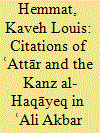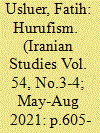| Srl | Item |
| 1 |
ID:
161394


|
|
|
|
|
| Summary/Abstract |
ʿAli Akbar Khatāyi’s Khatāynāmeh (Book of China), a detailed description of state and society in Ming China written in 922/1516, includes citations from the Kanz al-Haqāyeq (attributed to Mahmud Shabestari) and ʿAttār’s Elāhināmeh. By citing these two texts at key points in his description of the Chinese government, Khatāyi articulates a radical political vision in which the civil officials, rather than the emperor, are the true rulers. Furthermore, by using the Kanz al-Haqāyeq as a portal text, and through frequent citations of other gnostic poetry, he crafts his own authorial presence by identifying his own text with fotovvat and gnosticism, and invokes a conceptual framework based on the thought of Ibn ʿArabi epitomized in his intertexts.
|
|
|
|
|
|
|
|
|
|
|
|
|
|
|
|
| 2 |
ID:
178781


|
|
|
|
|
| Summary/Abstract |
In Hurufi history, the identity of Faḍlallāh’s children is a controversial subject. Although the Hurufi writings provide information on Faḍlallāh Astarābādī, the information related to his family has been analyzed incorrectly. More than ten different names for Faḍlallāh's children are in circulation. This lack of clarity prevents the precise historical analysis of his children. This article shares new findings regarding the Faḍlallāh family using a unique copy of Faḍlallāh’s genealogy, which provides a list of his children and grandchildren. Other sources, including Faḍlallāh’s testament, the Maḥramnāma, and primary Hurufi sources, are also considered. This article reveals Faḍlallāh’s four children, only three of whom were alive when he died, and the roles played by Faḍlallāh’s family at the time of Shāhrukh and Jahānshāh.
|
|
|
|
|
|
|
|
|
|
|
|
|
|
|
|